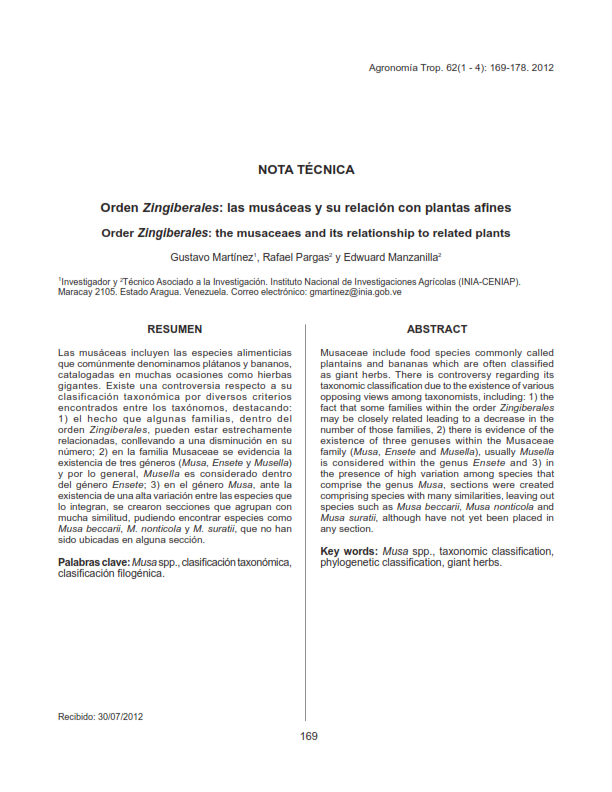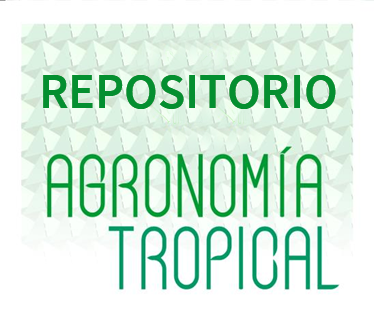Orden Zingiberales: las musáceas y su relación con plantas afines
Resumen
Las musáceas incluyen las especies alimenticias que comúnmente denominamos plátanos y bananos, catalogadas en muchas ocasiones como hierbas gigantes. Existe una controversia respecto a su clasificación taxonómica por diversos criterios encontrados entre los taxónomos, destacando: 1) el hecho que algunas familias, dentro del orden Zingiberales, pueden estar estrechamente relacionadas, conllevando a una disminución en su número; 2) en la familia Musaceae se evidencia la existencia de tres géneros (Musa, Ensete y Musella) y por lo general, Musella es considerado dentro del género Ensete; 3) en el género Musa, ante la existencia de una alta variación entre las especies que lo integran, se crearon secciones que agrupan con mucha similitud, pudiendo encontrar especies como Musa beccarii, M. nonticola y M. suratii, que no han sido ubicadas en alguna sección.
Descargas
Citas
• Alarcón, J. 2007. Enfermedades en la producción de Heliconias en los Departamentos de Caldas, Risaralda y Quindío. Caldas, Colombia. Agron. 15(1):45-61.
• Argent, G. 2000. Two interesting wild M L species (Musaceae) from Sabah, Malaysia. Gardens' Bulletin Singapore. 52:203-210.
• Cheesman, E. E. 1947 Classification of the bananas. II. The genus Musa L. Kew Bulletin. 2:106-117
• Ciciarelli, M., L. Passarelli y C. Rolleri. 2010. Morfología del polen en especies de Canna (Cannaceae) y su implicancia sistemática. Revista de Biología Tropical v.58 n.1. Disponible en línea: https://bit.ly/2WzK78C
• Ciciarelli, M. 2007. Canna ascendens (Cannaceae), una nueva especie de la provincia de Buenos Aires y comentarios sobre otras especies argentinas de este género. Darwiniana. 45(2):188-200.
• Constantine, D. 2004. Taxonomical debate: new specie Musella. INFOMUSA. 13(1):42-44
• Daniells, J., C. Jenny, D. Karamura et K. Tomekpe. 2001. Musalogue: A catalogue of Musa germplasm. Diversity in the genus Musa (E. Arnaud and S. Sharrock, compil.). International Network for the Improvement of Banana and Plantain (INIBAP). Montpellier (France). 207 p.
• Dos Santos-Serejo, J., F. Duarte y E. Amorim.2010. Banano ornamental: diversificación del uso de germoplasma para atender a nuevos mercados. Boletín Informativo Oficial de la Red de Investigación y Desarrollo de Banano y Plátano para América Latina y el Caribe (MUSALAC). 1(2):2.
• FAO (Organización de las Naciones Unidas para la Agricultura y la Alimentación). 2011. E15 Maranta arundinacea L. Sistema de información de recursos. Disponible en línea: https://bit.ly/2QzTYHy.
• Flowers of India. 2012. Scarlet Banana (on line). Consultado junio 2012. Disponible en línea: https://bit.ly/33AoDtz
• Freyre, M., C. Baigorria, V. Rozycki, C. Bernardi y M. Charpentier. 2000. Vegetales silvestres sub explotados del Chaco Argentino y su potencial como recurso alimenticio. Archivos Latinoamericanos de Nutrición.50(49):394-399. Disponible en línea: https://bit.ly/2WtURoV
• Frison, E. and S. Sharrock. 1998. The economic, social and nutritional importance of banana in the world. In Bananas and food security. Bananas and Food Security. Les productions bananières: un enjeu économique majeur pour la sécurité alimentaire. International Symposium. Session 1. Douala, Cameroon. Ed. By Picq C, Foure E, Frison E. INIBAP. CRBP. CIRAD. CTA. CF. FAO. pp. 21-35.
• Gardening Central. Musa coccinea: Some Interesting Facts about Musa Coccinea. Consultado junio 2012. Disponible en línea: https://bit.ly/2J6Pfc4
• Guzmán, A. y R. Guerrero. 2002. Efecto hipoglicemiande Costus speciosus en ratas. Vitae. Revista de la Facultad de Química Farmacéutica. Colombia. 9(1):51-57.
• Häkkinen, M. and S. Sharrock. 2002. Diversity in the genus Musa - Focus on Rhodochlamys. INIBAP. Annual Report 2001. INIBAP Networking Banana and Plantain: Montpellier (France). pp.16-23.
• Jerez, E. 2007. El cultivo de las heliconias. Cultivos Tropicales. Instituto Nacional Ciencias Agrícolas (INCA). La Habana, Cuba. Redalyc. Sistema de Información Científica. Red de Revistas Científicas de América Latina, el Caribe, España y Portugal 28(1):29-35. Disponible en línea: https://bit.ly/2J1LVz9
• Karamura D. 1999. Numerical taxonomic studies of the East African highland bananas (Musa AAA-East Africa) in Uganda. International Network for the Improvement of Banana and Plantain (INIBAP). (Claudine Picq, Emile Frison) France. 192 p.
• Kress, W., Prince, I., Hahn, W., Zimmer and E. 2001. Unraveling the Evolutionary Radiation of the Families of the Zingiberales Using Morphological andMolecular Evidence. Syst. Biol. 50(6):926–944.
• Kress, W., J., Prince, L., Hahn, M., Zimmer and E. 2002. The phylogeny and a new classification of the gingers (Zingiberaceae): evidence from molecular data. Amer. J. Bot. (89):1.682-1.696.
• Leong-Skornicková, J. 2011. Lowiaceae: adorable stinkadores. Gardenwise. The Magazine of the Singapore Botanic Gardens. January. Editores. Leong Chee Chiew, Mark Hughes, Khoon Meng Wong. Singapore Botanic. 36:1-44.
• Nigeria World. 2012. All about Nigeria. Consulta 12 May. Disponible en línea: https://bit.ly/3blVcyd
• Ortiz, R., A. López, S. Ponchner y A. Segura. 1999. El cultivo del banano. EUNED. San José, Costa Rica. 186 p.
• Pedersen, L. and B. Johansen. 2004. Anatomy of the unusua stigma in Orchidantha (Lowiaceae) Anatomy and Morphology. American Journal of Botany. 91:299-305
• Pérez, M., M. Sueiro, M. Boffill, F. Morón, M. Victoria, E. Monteagudo y G. Lorenzo. 2010. Actividad diurética de una decocción de Costus pictus. Revista Cubana de Plantas Medicinales 15(2). Disponible en: https://bit.ly/2Wymih6
• Prince, L. 2010. Phylogenetic relationships and species delimitation in Canna (Cannaceae). In: Diversity, phylogeny, and evolution in the monocotyledons. O Seberg, G Petersen, AS Barfod, and JI Davis (eds): Aarhus. Aarhus University Press. pp. 307-331.
• Rogers, G. 1984. The Zingiberales (Cannaceae, Marantaceae and Zingiberaceae) in the southeastern United States. J. Arnold Arbor. (65):5-55.
• Sakai, S. and T. Inoue. 1999. A new pollination system: dung-beetle pollination discovered in Orchidantha inouei (Lowiaceae, Zingiberales) in Sarawak, Malaysia. American Journal of Botany. 86(1):56-61.
• Sharrock, S. 2001. Diversity in the genus Musa focus on Australimusa. INIBAP Annual Report 2000. INIBAP Networking Banana and Plantain. Montpellier (France). pp. 14-19.
• Sharrock, S. 1998. The banana and its relatives. Focus paper III. INIBAP Annual Report. INIBAP Networking Banana and Plantain. Montpellier (France). pp. 52-55.
• Sharrock, S. 1997. Uses of Musa. 1996. Focus paper III. INIBAP Annual Report. INIBAP Networking Banana and Plantain. Montpellier (France). pp. 42-44.
• Sharrock, S. and J. Daniells. 1993. Musa ingens. The World’s Tallest Wild Banana. Global. INFOMUSA. The International Magazine on Banana and Plantain. INIBAP. Montpellier (France). pp. 2-8.
• Smithsonian Institution. 2012. Base de datos. Consultado 08 May. Smithsonian. National Museum of Natural History. Disponible en línea: https://s.si.edu/3abjBpJ
• Simmonds, N. W. 1962. The evolution of the babanas. London. Longmans. p. 170
• Simmonds, N. W. 1960. Notes on Banana Taxonomy. Kew Bulletin. Royal Botanic Gardens. 14(2):198-212.
• Soto, M. 1992. Banano, cultivo y comercialización.2da ed. Litografía e Imprenta Lil. Tibás, Costa Rica. 627 p.
Stevens, P. 2001. Angiosperm Phylogeny Website. Version 9, June 2008 [and more or less continuously updated since]." will do. Disponible en línea: https://bit.ly/3dlmcj9
• Suárez, L. 2010. Una especie nueva de Calathea (marantaceae) de Colombia. Caldasia. 32(2):295-299.
• The Angiosperm Phylogeny Group. 2003. An update of the Angiosperm Phylogeny Group classification for the orders and families of flowering plants: APG II. Botanical Journal of the Linnean Society. 141(4):399-436.
Valeton, T. H. 1918. New notes on the Zingiberaceae of Java and the Malaya archipielago. Bull. Jard. Bot. Buitenzorg. Ser. II 28. pp. 1-8
• Valmayor, R. V. y L. Dinh Danh. 2002. Clasificación y caracterización de Musella splendida sp. INFOMUSA. The International Magazine on Banana and Plantain INIBAP. Montpellier (France). 11(2):24-27.
• Wong, C, G. Argent, R. Kiev, O. Set and Y. Y. Gan. 2003. The genetic relations of Musa species from mount Jaya, New Guinea, and a reappraisal of the sections of Musa (Musaceae). Gardens Bulletin Singapore. 55(1):97-111.
• Wong, C., R. Kiew, G. Argent, O. Set, S. K. Lee and Y. Y. Gan. 2002. Assessment of the validity of the sections in Musa (Musaceae) using AFLP. Annals of Botany. 90(2):231-238.
• Wong, C., R. Kiew, A. Lamb, O. Set, S. K. Lee, L. H. Gan and Y. Y. Gan. 2001. Sectional placement of three Bornean species of Musa. Gardens Bulletin Singapore. 53(1):327-341.
• Wood, T. H., W. M. Whitten and N. H. Williams. 2000. Phylogeny of Hedychium and related genera (Zingiberaceae) based on its sequence data. Edinburgh Journal of Botany. 57(2):261-270
• Yun, Y., M. Satake, S. Katsuki and A. Kunugi. 2004. Phenylpropanoid derivatives from edible canna, Canna edulis. Phytochemistry. 65(14):2.167-2.171.
• Zhang, J., Z. Wang and Q. Mi. 2011. Polyphenol oxidase inhibitory and antioxidant activity of extract of Canna edulis ker stem. Journal of Food Biochemistry. 35(4):1.342-1.360.
• Zipcodezoo. 2012. Musa coccinea (Banana). Consultado junio 2012. Disponible en línea: https://bit.ly/2vBe2ls





